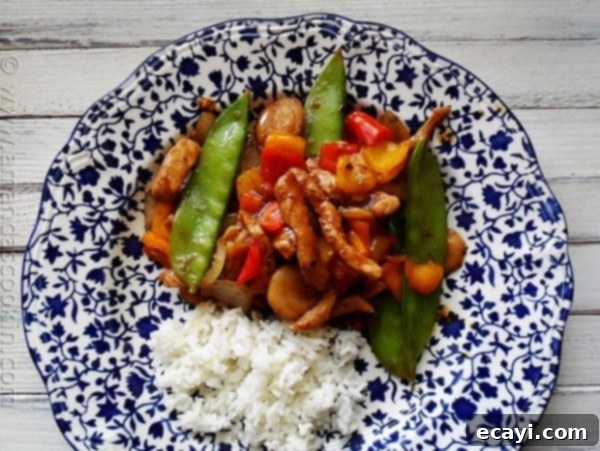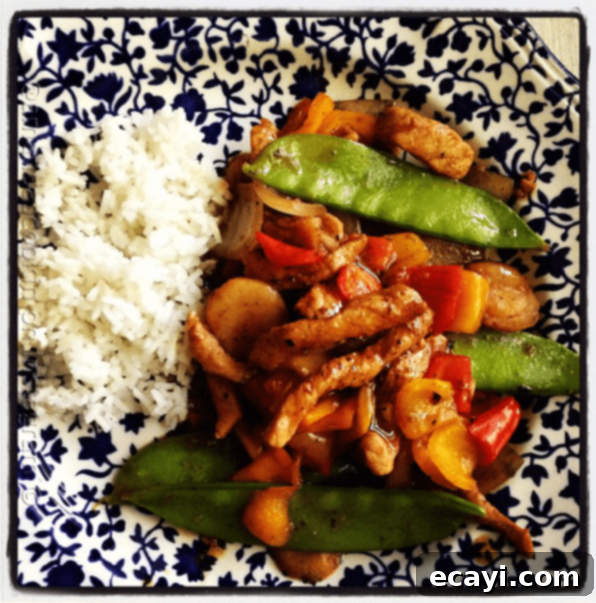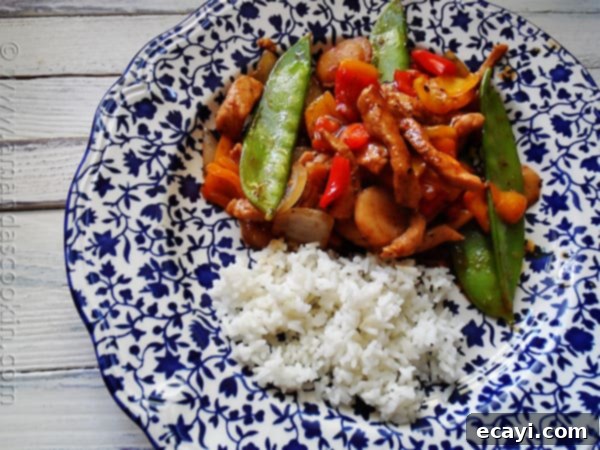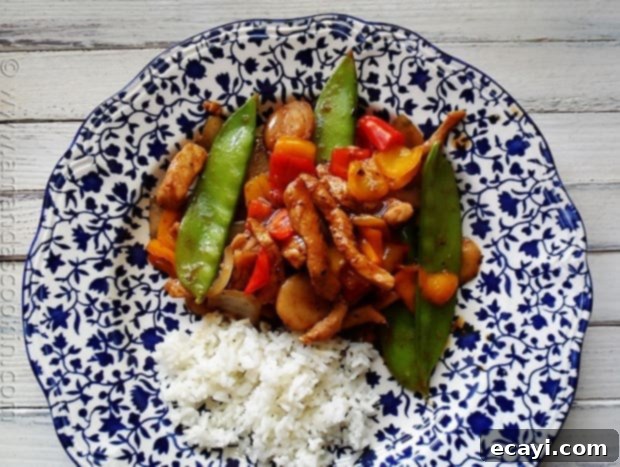Ultimate Peppered Pork Stir Fry with Sweet Peppers: A Quick & Flavorful Weeknight Meal
 There’s something truly magical about a well-executed stir fry. It’s more than just a meal; it’s a vibrant symphony of fresh ingredients, tender proteins, and an irresistible sauce, all coming together in minutes. For me, stir-frying has become a culinary superpower – a way to transform simple ingredients into a delicious dinner with minimal fuss. This Peppered Pork Stir Fry with Sweet Peppers is a prime example of this magic, delivering incredible flavor and satisfying textures that will make it an instant family favorite.
There’s something truly magical about a well-executed stir fry. It’s more than just a meal; it’s a vibrant symphony of fresh ingredients, tender proteins, and an irresistible sauce, all coming together in minutes. For me, stir-frying has become a culinary superpower – a way to transform simple ingredients into a delicious dinner with minimal fuss. This Peppered Pork Stir Fry with Sweet Peppers is a prime example of this magic, delivering incredible flavor and satisfying textures that will make it an instant family favorite.
My journey with stir-fries began years ago, experimenting with countless combinations and creating my own recipes. This particular rendition, featuring lean pork loin and an abundance of colorful sweet peppers, is one I’m especially proud of. It balances savory, slightly sweet, and tangy notes, all enhanced by a generous amount of freshly ground black pepper. This isn’t just another weeknight meal; it’s an experience that brings the deliciousness of Asian-inspired cuisine right to your kitchen.
 One of the secrets to my stir-fry success often starts at the grocery store. I frequently find fantastic deals on large pork loins, particularly at warehouse clubs like Sam’s Club. These large cuts are incredibly versatile – I can butcher them into roasts, individual pork chops, and, crucially for stir-fries, perfect thin strips of pork. This approach not only saves money but also ensures I always have high-quality, lean protein ready for a quick meal. Recently, I stumbled upon beautiful bags of colorful mini sweet peppers, and I immediately knew they were destined for this dish. Their vibrant hues and mild, sweet crunch are absolutely perfect for stir-fries, adding both visual appeal and a delightful flavor dimension.
One of the secrets to my stir-fry success often starts at the grocery store. I frequently find fantastic deals on large pork loins, particularly at warehouse clubs like Sam’s Club. These large cuts are incredibly versatile – I can butcher them into roasts, individual pork chops, and, crucially for stir-fries, perfect thin strips of pork. This approach not only saves money but also ensures I always have high-quality, lean protein ready for a quick meal. Recently, I stumbled upon beautiful bags of colorful mini sweet peppers, and I immediately knew they were destined for this dish. Their vibrant hues and mild, sweet crunch are absolutely perfect for stir-fries, adding both visual appeal and a delightful flavor dimension.
Why This Peppered Pork Stir Fry Will Become Your Go-To Recipe
If you’re looking for a dish that’s both impressive and incredibly easy to make, you’ve found it. This peppered pork stir fry recipe stands out for several reasons:
- Speed and Efficiency: Aside from the quick chopping of vegetables, you’ll spend less than 20-25 minutes actively cooking, making it an ideal choice for busy weeknights.
- Bursting with Flavor: The combination of marinated pork, fresh sweet peppers, and a savory sauce creates a complex yet harmonious flavor profile that’s incredibly satisfying.
- Nutrient-Rich: Packed with lean protein from the pork and a rainbow of vitamins and antioxidants from the sweet peppers and other vegetables, it’s a wholesome meal for the whole family.
- Customizable: While delicious as is, this recipe is also highly adaptable. Feel free to experiment with different vegetables or even proteins to suit your taste.
The Perfect Pork: Selecting and Preparing Your Loin
Pork loin is an excellent choice for stir-frying because it’s lean, tender, and cooks quickly. When you buy a larger pork loin, you have the flexibility to portion it out. For stir-fry, the key is consistency in your cuts. Aim for thin, bite-sized strips, about ¼ to ½ inch thick and 2-3 inches long. This ensures even cooking and allows the meat to absorb the marinade beautifully.
Our marinade for the pork is simple yet effective: fresh ground black pepper, cornstarch, soy sauce, and black vinegar. The black pepper adds a fantastic aromatic warmth and a subtle kick, living up to the “peppered” in the name. Cornstarch is crucial here – it tenderizes the pork, giving it a silky texture, and also helps to slightly thicken the sauce later. Soy sauce provides umami and saltiness, while black vinegar offers a delightful tangy depth that brightens the overall flavor profile. Allow the pork to marinate for at least 15-20 minutes while you prepare your vegetables; even a short marination time makes a significant difference.
Sweet Peppers: The Star Vegetable of the Dish
 Those small, colorful sweet peppers are not just pretty to look at; they are a fantastic ingredient for stir-fries. Unlike bell peppers, sweet mini peppers tend to be less watery and retain a lovely crisp-tender texture even after a quick sauté. They bring a natural sweetness that complements the savory pork and rich sauce without overpowering the dish. Plus, their vibrant reds, yellows, and oranges add a beautiful visual appeal to your plate, making dinner feel a little more special. You can chop them into bite-sized pieces or thin strips, whichever you prefer.
Those small, colorful sweet peppers are not just pretty to look at; they are a fantastic ingredient for stir-fries. Unlike bell peppers, sweet mini peppers tend to be less watery and retain a lovely crisp-tender texture even after a quick sauté. They bring a natural sweetness that complements the savory pork and rich sauce without overpowering the dish. Plus, their vibrant reds, yellows, and oranges add a beautiful visual appeal to your plate, making dinner feel a little more special. You can chop them into bite-sized pieces or thin strips, whichever you prefer.
Crafting the Irresistible Stir Fry Sauce
A great stir fry lives and dies by its sauce, and this recipe features a truly exceptional one. It’s a harmonious blend of classic Asian pantry staples: chicken broth, oyster sauce, sesame oil, and a touch more soy sauce. Each component plays a vital role:
- Chicken Broth: Forms the liquid base of the sauce, ensuring it’s not too thick or overpowering.
- Oyster Sauce: This is a secret weapon for umami. It adds a deep, savory, slightly sweet flavor that’s hard to replicate. Don’t skip it!
- Sesame Oil: Infuses the sauce with its distinctive nutty aroma, adding an authentic Asian flair.
- Soy Sauce: Contributes salinity and another layer of umami, balancing the other flavors.
- Fresh Aromatics: Minced garlic and freshly grated ginger form the aromatic foundation, providing pungent, zesty notes that awaken the palate. Using fresh ingredients here makes a world of difference compared to dried or jarred alternatives.
Whisk all these sauce ingredients together beforehand. This “mise en place” (everything in its place) is critical for stir-frying, as the cooking process is incredibly fast. Having your sauce ready to pour in ensures a smooth and stress-free cooking experience.
Essential Tips for Stir-Frying Success
While stir-frying is quick, a few techniques can elevate your dish from good to extraordinary:
- High Heat is Key: A hot wok or large skillet is essential. The high heat creates that characteristic “wok hei” (breath of the wok) flavor, giving the food a slightly smoky, seared taste. Ensure your pan is shimmering with oil before adding ingredients.
- Don’t Overcrowd the Pan: Cooking in batches, especially the meat, prevents the temperature from dropping too low. Overcrowding will steam your ingredients instead of stir-frying them, leading to a less desirable texture.
- Prep Everything First: Once you start stir-frying, there’s no time to chop. Have all your ingredients – pork, vegetables, and sauce – prepped and within arm’s reach.
- Sequence Matters: Cook the protein first, remove it, then stir-fry the harder vegetables, followed by softer ones. Add the cooked protein back in at the end before pouring in the sauce. This ensures everything cooks perfectly without becoming overdone.

Peppered Pork Stir Fry with Sweet Peppers
IMPORTANT – Be sure to read the full blog post above for helpful tips, substitutions, and answers to frequently asked questions about this recipe!
Print It
Pin It
Rate It
Save ItSaved!
Ingredients
- 2 tablespoons of canola oil
- ½ pound of pork loin cut into thin strips
- Fresh ground black pepper
- 2 tablespoons cornstarch
- 1 tablespoon soy sauce
- 1 tablespoon black vinegar
- ¾ cup chicken broth
- 3 tablespoons oyster sauce
- 2 tablespoons sesame oil
- 2 teaspoons soy sauce
- 4 cloves minced garlic about 2 teaspoons
- 2 teaspoons freshly grated ginger
- 1 pound sweet peppers chopped
- ½ pound fresh snow peas
- 1 medium white or yellow onion chopped
- 8 oz can sliced water chestnuts drained
Before You Begin
Polyunsaturated Fat 4.4 g
Monounsaturated Fat 6.8 g
Cholesterol 36.6 mg
Sodium 544.4 mg
Potassium 737.6 mg
Total Carbohydrate 24.3 g
Dietary Fiber 3.9 g
Sugars 3.5 g
Protein 16.0 g
Instructions
-
Place meat into a bowl and season generously with freshly ground black pepper. Mix cornstarch with soy sauce and black vinegar until completely combined. Pour mixture over the meat and mix it with a spoon to coat. Set aside to marinate.
-
For the sauce combine the broth, oyster sauce, sesame oil, and soy sauce in a bowl. Whisk to combine and set aside.
-
Heat wok over medium high heat. Add canola oil and heat until shimmering but not smoking. Stir fry meat in oil until no longer pink. Remove meat and set aside.
-
Add garlic, ginger, sweet peppers, snow peas and onions to hot wok. Stir fry until tender crisp, about 2-3 minutes. Add water chestnuts and stir fry 1-2 minutes more.
-
Add meat to the vegetable and stir to combine. Pour sauce mixture into the pan and bring to a boil. Stir occasionally until sauce has thickened.
-
Serve over your favorite rice or noodles.
Serving Suggestions & Delicious Variations
This Peppered Pork Stir Fry with Sweet Peppers is incredibly versatile. It’s most commonly served over fluffy white rice, such as jasmine rice, which perfectly soaks up the savory sauce. However, don’t limit yourself!
- Noodle Bowls: Serve it over lo mein noodles, rice vermicelli, or even ramen for a heartier meal.
- Healthier Grains: For a nutrient boost, consider brown rice, quinoa, or cauliflower rice.
- Garnishes: A sprinkle of toasted sesame seeds, chopped green onions, or fresh cilantro can add an extra layer of flavor and visual appeal.
Want to switch things up? Here are some delicious variations:
- Protein Swaps: Not a fan of pork? This recipe works beautifully with thinly sliced chicken breast or thighs, beef sirloin or flank steak, shrimp, or even firm tofu for a vegetarian option. Adjust cooking times accordingly.
- Vegetable Additions: Feel free to incorporate other stir-fry friendly vegetables. Broccoli florets, sliced carrots, mushrooms, bok choy, or bamboo shoots would all be excellent additions. Just remember to add harder vegetables first to ensure they cook through.
- Spice It Up: If you enjoy a bit of heat, add a pinch of red pepper flakes with the garlic and ginger, or drizzle some Sriracha or chili oil over the finished dish.
- Extra Crunch: A handful of chopped cashews or peanuts added at the end can provide a wonderful textural contrast.
Frequently Asked Questions (FAQs)
To help you master this Peppered Pork Stir Fry, here are answers to some common questions:
- Can I prepare this stir fry ahead of time?
Absolutely! You can marinate the pork up to 24 hours in advance in the refrigerator. All your vegetables can be chopped and stored in airtight containers a day or two before. The sauce can also be mixed and stored in the fridge. This makes assembly on a busy weeknight incredibly fast. - What if I don’t have black vinegar?
While black vinegar adds a unique depth, you can substitute it with rice vinegar, or a mix of balsamic vinegar and a tiny pinch of sugar if you’re looking for a closer flavor profile. The dish will still be delicious! - My sauce isn’t thickening. What should I do?
Ensure your sauce includes cornstarch as instructed, and that it comes to a rolling boil. Stirring continuously for a minute or two at a boil should activate the cornstarch and thicken the sauce. If it’s still too thin, mix a teaspoon of cornstarch with a tablespoon of cold water (a “slurry”) and whisk it into the boiling sauce, stirring until it thickens. - How do I store leftovers?
Leftovers can be stored in an airtight container in the refrigerator for up to 3-4 days. Reheat gently in a microwave or on the stovetop, adding a splash of broth or water if the sauce has become too thick. - Can I use frozen vegetables?
Yes, you can. However, fresh vegetables are generally preferred for stir-fries as they retain their crispness better. If using frozen, thaw them first and pat them dry to remove excess moisture, which can make the stir fry watery. - Is pork loin the only cut of pork I can use?
Pork loin is ideal for its leanness and tenderness. Pork tenderloin is also an excellent (and often more tender) option. Pork shoulder or butt can be used, but it’s fattier and requires longer cooking times, making it less suitable for a quick stir-fry.
This Peppered Pork Stir Fry with Sweet Peppers is more than just a recipe; it’s an invitation to experience the joy of fast, fresh, and profoundly flavorful home cooking. It’s proof that a quick meal doesn’t have to compromise on taste or quality. So gather your ingredients, fire up your wok, and prepare to be amazed by how easily you can create a restaurant-quality dish right in your own kitchen. Enjoy every savory, peppery, sweet bite!
The recipes on this blog are tested with a conventional gas oven and gas stovetop. It’s important to note that some ovens, especially as they age, can cook and bake inconsistently. Using an inexpensive oven thermometer can assure you that your oven is truly heating to the proper temperature. If you use a toaster oven or countertop oven, please keep in mind that they may not distribute heat the same as a conventional full sized oven and you may need to adjust your cooking/baking times. In the case of recipes made with a pressure cooker, air fryer, slow cooker, or other appliance, a link to the appliances we use is listed within each respective recipe. For baking recipes where measurements are given by weight, please note that results may not be the same if cups are used instead, and we can’t guarantee success with that method.
